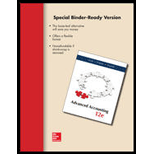
Advanced Accounting (Looseleaf)
12th Edition
ISBN: 9780077632595
Author: Hoyle
Publisher: MCG
expand_more
expand_more
format_list_bulleted
Textbook Question
Chapter 14, Problem 18Q
When a partner withdraws from a
Expert Solution & Answer
Want to see the full answer?
Check out a sample textbook solution
Students have asked these similar questions
Can you explain the correct approach to solve this financial accounting question?
I need assistance with this financial accounting question using appropriate principles.
Please help me solve this financial accounting problem with the correct financial process.
Chapter 14 Solutions
Advanced Accounting (Looseleaf)
Ch. 14 - Prob. 1QCh. 14 - Prob. 2QCh. 14 - Prob. 3QCh. 14 - Prob. 4QCh. 14 - Prob. 5QCh. 14 - Prob. 6QCh. 14 - Prob. 7QCh. 14 - Prob. 8QCh. 14 - Prob. 9QCh. 14 - Prob. 10Q
Ch. 14 - Prob. 11QCh. 14 - Prob. 12QCh. 14 - What is a partnership dissolution? Does...Ch. 14 - Prob. 14QCh. 14 - Prob. 15QCh. 14 - Prob. 16QCh. 14 - Prob. 17QCh. 14 - When a partner withdraws from a partnership, why...Ch. 14 - Prob. 1PCh. 14 - Prob. 2PCh. 14 - Prob. 3PCh. 14 - Prob. 4PCh. 14 - Prob. 5PCh. 14 - Prob. 6PCh. 14 - Prob. 7PCh. 14 - Prob. 8PCh. 14 - Prob. 9PCh. 14 - Prob. 10PCh. 14 - Prob. 11PCh. 14 - Prob. 12PCh. 14 - Prob. 13PCh. 14 - Prob. 14PCh. 14 - Prob. 15PCh. 14 - Prob. 16PCh. 14 - Prob. 17PCh. 14 - Prob. 18PCh. 14 - Prob. 19PCh. 14 - Prob. 20PCh. 14 - Prob. 21PCh. 14 - Prob. 22PCh. 14 - Prob. 23PCh. 14 - Prob. 24PCh. 14 - Prob. 25PCh. 14 - Prob. 26PCh. 14 - Following is the current balance sheet for a local...Ch. 14 - Prob. 28PCh. 14 - Prob. 29PCh. 14 - Prob. 30PCh. 14 - Prob. 31PCh. 14 - Prob. 2DYSCh. 14 - Prob. 3DYSCh. 14 - Prob. 4DYSCh. 14 - Prob. 5DYS
Knowledge Booster
Learn more about
Need a deep-dive on the concept behind this application? Look no further. Learn more about this topic, accounting and related others by exploring similar questions and additional content below.Similar questions
- Can you explain the process for solving this financial accounting problem using valid standards?arrow_forwardCan you solve this general accounting problem with appropriate steps and explanations?arrow_forwardPlease explain the correct approach for solving this general accounting question.arrow_forward
- I am trying to find the accurate solution to this financial accounting problem with appropriate explanations.arrow_forwardI need help finding the correct solution to this financial accounting problem with valid methods.arrow_forwardCan you help me solve this general accounting problem with the correct methodology?arrow_forward
- I need help with this financial accounting problem using proper accounting guidelines.arrow_forwardPlease provide the solution to this general accounting question using proper accounting principles.arrow_forwardI need help finding the accurate solution to this general accounting problem with valid methods.arrow_forward
- When incorporating his sole proprietorship, Joe transfers all of its assets and liabilities. Included in the $30,000 of liabilities assumed by the corporation is $500 that relates to a personal expenditure. Under these circumstances, the entire $30,000 will be treated as boot. / Provide explanation please a. True b. Falsearrow_forwardIn determining whether § 357(c) applies, assess whether the liabilities involved exceed the bases of all assets a shareholder transfers to the corporation./ Provide explanation please. a. True b. Falsearrow_forwardI will unhelpful if wrong.arrow_forward
arrow_back_ios
SEE MORE QUESTIONS
arrow_forward_ios
Recommended textbooks for you
- Principles of Accounting Volume 1AccountingISBN:9781947172685Author:OpenStaxPublisher:OpenStax College
 College Accounting, Chapters 1-27AccountingISBN:9781337794756Author:HEINTZ, James A.Publisher:Cengage Learning,
College Accounting, Chapters 1-27AccountingISBN:9781337794756Author:HEINTZ, James A.Publisher:Cengage Learning,

Principles of Accounting Volume 1
Accounting
ISBN:9781947172685
Author:OpenStax
Publisher:OpenStax College


College Accounting, Chapters 1-27
Accounting
ISBN:9781337794756
Author:HEINTZ, James A.
Publisher:Cengage Learning,

What is liquidity?; Author: The Finance Storyteller;https://www.youtube.com/watch?v=XtjS7CfUSsA;License: Standard Youtube License